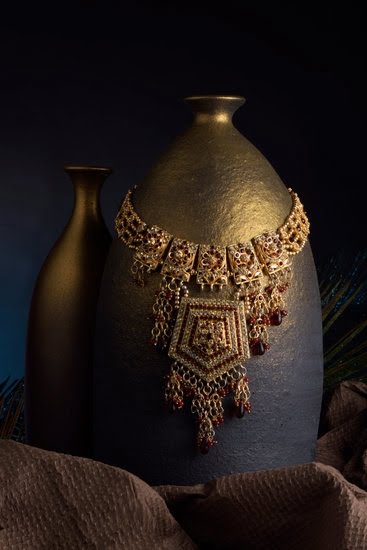Do you ever wonder, “does gold jewelry tarnish?” Gold jewelry has been a symbol of luxury and elegance for centuries. Whether it’s a wedding band, a pair of earrings, or a stunning necklace, gold jewelry has been treasured for its beauty and durability.
In this article, we will explore the factors that cause tarnishing in jewelry, specifically focusing on gold. We will also discuss whether gold actually tarnishes and ways to prevent and maintain the timeless beauty of your precious gold pieces.
Gold is a timeless metal that has been prized for its luster and rarity throughout history. It has been used to create exquisite pieces of jewelry that are passed down through generations. However, even though gold is a noble metal, it is not entirely immune to tarnishing. Understanding what causes tarnishing in jewelry, including gold, is essential to preserving its beauty and value.
In the following sections, we will delve into the factors that can cause tarnishing in gold jewelry. We will also explore the different types of gold jewelry and their properties when it comes to tarnishing.
Additionally, we will provide useful tips on how to prevent tarnishing from occurring and how to effectively clean and maintain your precious gold pieces for years to come. Let’s uncover the secrets of keeping your gold jewelry looking as radiant as the day you first laid eyes on it.
What Causes Tarnishing in Jewelry
Tarnishing in jewelry is often caused by a chemical reaction between the metal and substances in the environment. The main culprits for tarnishing are exposure to air, moisture, and certain chemicals. When gold jewelry comes into contact with these elements, it can cause a thin layer of tarnish to develop on the surface of the metal. Furthermore, if gold jewelry is stored improperly or not cleaned regularly, tarnishing can occur at a faster rate.
In addition to environmental factors, another common cause of tarnishing in gold jewelry is alloying metals. Pure gold is too soft to be used in jewelry production, so it is often mixed with other metals such as silver, copper, or nickel to give it strength and durability. However, these alloying metals can also contribute to tarnishing when they react with the environment or come into contact with certain substances.
Preventing Tarnishing in Gold Jewelry
To prevent tarnishing in gold jewelry, there are several steps you can take. Storing your gold jewelry in airtight containers when not being worn can help protect it from exposure to air and moisture. Additionally, avoiding contact with household chemicals such as bleach and sulfur-containing compounds can help prevent tarnishing. Regular cleaning and maintenance of your gold jewelry using appropriate techniques can also aid in preventing tarnish buildup over time.
| Cause of Tarnishing | Preventive Measures |
|---|---|
| Chemical reaction with air, moisture, and certain chemicals | Store jewelry in airtight containers; avoid contact with household chemicals |
| Alloying metals reacting with the environment | Regular cleaning and maintenance; proper storage |
Does Gold Tarnish?
Gold jewelry has long been cherished for its timeless beauty and elegance. Whether it’s a delicate gold necklace, a pair of hoop earrings, or a stunning engagement ring, gold jewelry has been a symbol of luxury and sophistication for centuries. But one common concern that many people have when it comes to gold jewelry is whether or not it tarnishes.
Does Gold Tarnish?
When it comes to gold jewelry, the good news is that pure gold does not tarnish. This is because pure gold is a very stable metal and does not react with the environment. However, most gold jewelry on the market is not made from 100% pure gold.
Instead, it is usually alloyed with other metals such as silver, copper, or zinc to make it more durable and affordable. It is these other metals that can cause the tarnishing of gold jewelry.
To better understand how different types of gold jewelry may tarnish differently due to their composition, here are the types of gold commonly used in jewelry:
- 24 karat (100% pure) gold: Does not tarnish
- 18 karat (75% gold): Less likely to tarnish
- 14 karat (58.3% gold): More prone to tarnishing
- 10 karat (41.7% gold): Most vulnerable to tarnishing
In order to prevent tarnishing and keep your gold jewelry looking its best, there are several steps you can take:
- Avoid exposing your jewelry to chemicals such as perfume, lotion, and hairspray.
- Store your jewelry in a dry environment away from moisture.
- Clean your jewelry regularly using mild soap and water.
Different Types of Gold Jewelry and Their Tarnishing Properties
When it comes to gold jewelry, there are different types of gold that are used in the making of these accessories. Each type of gold has its own unique properties that can impact its tendency to tarnish. Whether you’re wearing a gold necklace, bracelet, or earrings, it’s important to understand how different types of gold may react over time.
24K Gold
24K gold is pure gold and is the most resistant to tarnishing. It does not mix with any other metals, which makes it less prone to discoloration or tarnishing. However, due to its softness, 24K gold is not commonly used in jewelry as it can easily get scratched or bent.
18K Gold
18K gold is made up of 75% pure gold and 25% other metals like copper or silver. These additional metals can cause some tarnishing over time, especially if the jewelry comes into contact with substances like perfume, lotions, or sweat.
14K Gold
14K gold contains 58.3% pure gold and is more durable and less prone to tarnishing compared to higher karat options like 18K or 24K. The added alloys make this type of gold more suitable for everyday wear as they provide increased strength and resistance to tarnishing.
Ultimately, the karatage of the gold jewelry will determine its likelihood of tarnishing over time. Understanding the properties of each type of gold can help you make an informed decision when selecting your next piece of jewelry and taking steps to prevent any potential tarnishing issues.
How to Prevent Tarnishing in Gold Jewelry
Gold jewelry is a timeless and elegant accessory that can elevate any outfit or look. To keep its luster and shine, it’s important to take steps to prevent tarnishing. Here are some tips on how to prevent tarnishing in gold jewelry:
1. Keep it dry: Moisture can cause tarnishing in gold jewelry, so be sure to remove your gold pieces before swimming or taking a shower. After washing your hands, make sure to thoroughly dry your gold jewelry with a soft cloth.
2. Store properly: When not in use, store your gold jewelry in a cool, dry place away from direct sunlight. Consider keeping your pieces in individual cloth pouches or separate compartments in a jewelry box to prevent scratching and tangling.
3. Avoid exposure to chemicals: Chemicals like chlorine, perfumes, lotions, and hairspray can cause discoloration and tarnishing in gold jewelry. It’s best to put on your gold pieces after applying these products and remove them before using harsh cleaning agents.
By following these simple preventive measures, you can prolong the lustrous appearance of your gold jewelry and keep it looking as good as new for years to come.
Additionally, getting your gold jewelry professionally cleaned and polished every now and then can also help maintain its shine and beauty. Be sure to visit a reputable jeweler who specializes in cleaning and caring for fine jewelry.
Cleaning and Maintenance Tips for Gold Jewelry
Gold jewelry is a popular choice for many people due to its timeless and elegant look. However, it is important to properly care for and maintain gold jewelry to keep it looking its best. One common concern that many individuals have is whether gold jewelry tarnishes over time.
Tarnishing in gold jewelry can occur due to a variety of reasons such as exposure to chemicals, moisture, and even certain skin types that can cause the metal to become discolored. However, pure gold itself does not tarnish. It is actually the other metals mixed with gold in the jewelry that are prone to tarnishing.
The most common types of gold jewelry are 24 karat, 18 karat, and 14 karat. Generally, the higher the karat of the gold, the less likely it is to tarnish because of the higher purity of gold in the piece. For example, 24 karat gold is more resistant to tarnishing than 14 karat gold due to its higher purity. However, all types of gold jewelry can benefit from regular cleaning and maintenance to prevent tarnishing.
To prevent tarnishing in your gold jewelry, it’s important to store them properly in a clean and dry environment when not being worn. Avoid exposing your jewelry to harsh chemicals or abrasive materials that can cause damage or discoloration. Additionally, regular cleaning using a mild soap and water solution can help remove any built-up dirt or oils that may contribute to tarnishing over time.
| Gold Jewelry Type | Tarnishing Properties |
|---|---|
| 24 Karat Gold | Less likely to tarnish due to higher purity |
| 18 Karat Gold | Moderate tendency to tarnish depending on other metals used |
| 14 Karat Gold | More prone to tarnishing due to lower purity |
Common Misconceptions About Gold Tarnishing
There are several misconceptions about gold jewelry and its tarnishing properties that many people believe to be true. In this section, we will address some of these common misconceptions and provide clarity on the topic.
Gold Is Immune to Tarnishing
One of the most common misconceptions about gold jewelry is that it is completely immune to tarnishing. While gold is a relatively non-reactive metal and does not corrode easily, it can still tarnish over time. Tarnishing in gold jewelry may not be as pronounced as in other metals, but it can still occur under certain conditions.
All Gold Jewelry Is Created Equal
Another misconception is that all types of gold jewelry have the same tarnishing properties. In reality, different types of gold alloys and karats can have varying degrees of susceptibility to tarnishing. For example, 24 karat pure gold is less likely to tarnish compared to lower karat alloys that contain other metals such as copper or silver.
Tarnished Gold Means It’s Fake
It is often believed that if a piece of gold jewelry appears tarnished, then it must be fake. However, this is not necessarily true. Tarnishing can occur even in genuine gold jewelry due to environmental factors and the presence of other metals in the alloy. The presence of tarnish does not necessarily indicate the authenticity of the gold used in the jewelry piece.
Final Thoughts
In conclusion, gold jewelry is renowned for its timeless beauty and proven durability. While pure gold does not tarnish, alloyed gold jewelry may tarnish due to the presence of other metals like copper and nickel. However, with proper care and maintenance, you can keep your gold jewelry looking its best for years to come.
It’s important to note that the frequency of tarnishing on gold jewelry largely depends on the type of alloy used. For example, 14K gold is more resistant to tarnishing compared to 10K or 18K gold. Understanding the composition of your gold jewelry can help you anticipate and address any potential tarnishing issues.
To prevent tarnishing in your gold jewelry, it is recommended to store it properly when not in use, clean it regularly with a mild detergent and soft brush, and avoid exposing it to harsh chemicals. Additionally, be cautious of common misconceptions about gold tarnishing, such as assuming that higher karat values mean better resistance to tarnish. By taking these preventive measures, you can ensure that your gold jewelry maintains its lustrous shine for many years.
In the end, keeping your gold jewelry looking its best doesn’t have to be a daunting task. With a little care and attention, you can enjoy the enduring elegance of this precious metal for generations to come. Remember that while some types of gold may be prone to tarnishing over time, proper maintenance will preserve the beauty and value of your cherished pieces.
Frequently Asked Questions
Does Real 14k Gold Tarnish?
Real 14k gold does not tarnish. Gold is a noble metal, which means it is resistant to corrosion and tarnishing. This makes it a popular choice for jewelry as it maintains its luster and shine over time.
How Do You Keep Gold Jewelry From Tarnishing?
To keep gold jewelry from tarnishing, it’s important to store it properly when not in use. Avoid exposing it to chemicals such as perfume, lotions, and household cleaners, as these can cause buildup and dullness on the surface of the jewelry. Regular cleaning with a mild soap and water solution can also help maintain its luster.
Can Real Gold Look Tarnished?
While real gold itself does not tarnish, it can appear tarnished if there are impurities mixed in with the gold alloy or if dirt and oils accumulate on the surface of the jewelry. In these cases, a thorough cleaning using mild soap and water or professional cleaning by a jeweler can restore the gold’s appearance to its original shine.

Welcome to my jewelry blog! My name is Sarah and I am the owner of this blog.
I love making jewelry and sharing my creations with others.
So whether you’re someone who loves wearing jewelry yourself or simply enjoys learning about it, be sure to check out my blog for insightful posts on everything related to this exciting topic!





